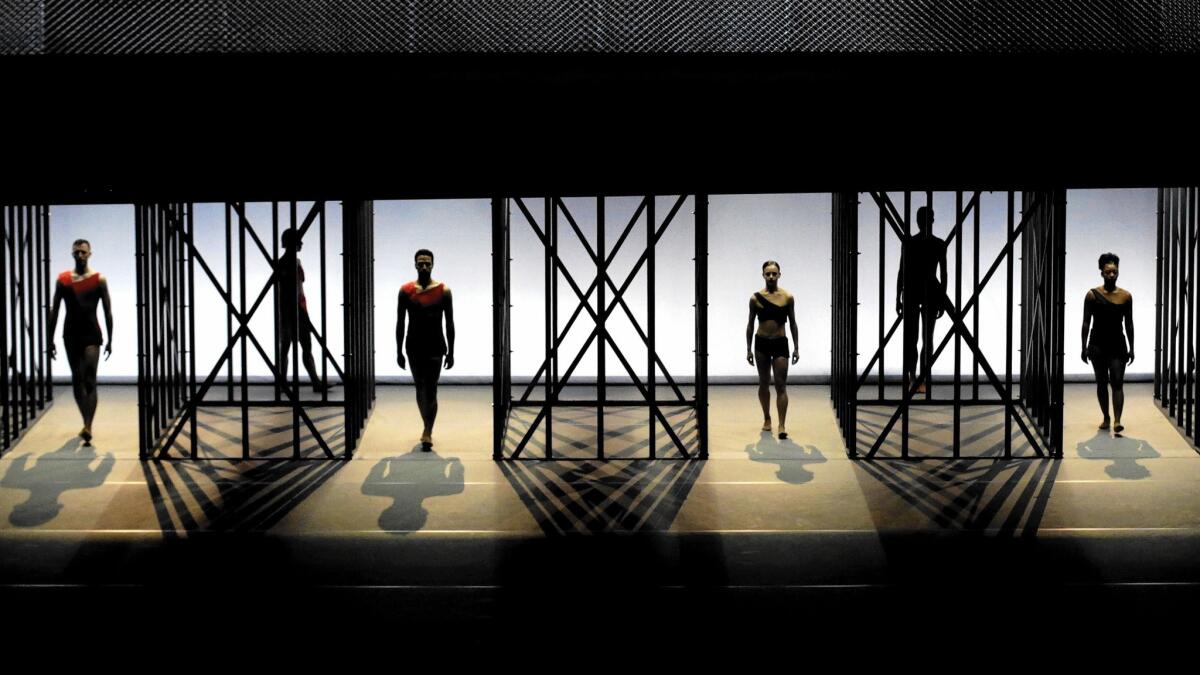Review: After 32 years, ‘Available Light’ brighter than ever

- Share via
The idea of reviving a 32-year-old collaboration between composer John Adams, choreographer Lucinda Childs and architect Frank Gehry that had been commissioned by the Museum of Contemporary Art to open its Temporary Contemporary space (now the Geffen Contemporary) might seem a peculiar way to celebrate the Music Center’s 50th anniversary and an especially peculiar end of the Los Angeles Philharmonic’s season in Walt Disney Concert Hall.
“Available Light” is a 50-minute dance piece that has nothing to do with the Music Center. Adams’ score is electronic, so it has nothing to do with the orchestra. Performed Friday and Saturday night as the penultimate event in the Next on Grand festival, the work had nothing to do with Grand Avenue, the Geffen being in Little Tokyo.
Nor was the premiere in 1983 particularly well received. Martin Bernheimer ended his Times review with the memorable line: “If this really is the best ‘Light’ available, let there be darkness.” After a brief tour to the Brooklyn Academy of Music and Europe, “Available Light” went mostly into eclipse.
ESSENTIAL ARTS & CULTURE NEWSLETTER >> Get great stories delivered to your inbox
But three decades of darkness have finally come to an end. In retrospect, “Available Light” is a revelation.
It has everything to do with the Music Center and the L.A. Phil. Not only is “Available Light” a compelling interplay between dance, music and setting — gorgeous to behold and thrilling to hear — but the work now brilliantly illuminates how three American artists on the cusp of greatness made the momentous leap.
It took only walking into Disney on Friday night and seeing the joyfully jutting organ pipes made to appear mysteriously floating in air behind a chain-link scrim to realize an act of magical transformation was to occur. At the Temporary Contemporary, a vast warehouse that Gehry had converted into gallery space for MOCA, the architect had produced a remarkable two-level set for the dancers, with two sets of bleachers for the audience, one facing the front of the stage (which had chain-link as a backdrop) and another at right angles. This was Gehry’s first exploration of the idea of including an audience as part of the show that eventually led to the Disney auditorium concept.
A big blast of horns over loudspeakers at the start of Adams’ score for synthesizer and pre-recorded brass indicates he had been listening to Sibelius as much as to Steve Reich. In three effusive movements, Adams embraced catchy repetitions while also exploring long passages of moody harmonies and rich drones in which colors and textures slowly changed without pulse. The initial legacy of “Light Over Water” (as Adams named the score) was a mammoth writer’s block and period of Jungian therapy before he found a way to resolve the two impulses in his first major orchestral score, “Harmonielehre.”
Childs’ reaction to Gehry and Adams was to amplify the complications of duality. On the main stage, varying-sized groups of dancers in red, white or black form fluid pairings, doubled by individual dancers on the smaller upper level. The radical overall effect is that of dance not only as horizontal but vertical geometry. This was precedent to Childs’ dazzling choreography for the 1984 revival of Philip Glass and Robert Wilson’s “Einstein on the Beach,” and Childs’ company is the same exuberant one that was seen at the Music Center two years ago.
Disney’s “Light” revival involved modifications and updating including replacing fashion designer Ronaldus Shamask’s original billowy full-body costumes with skimpier designs by Kasia Walicka Maimone better suited to the sculpted bodies of today’s dancers. Mark Grey’s modern sound design offered all the benefits of loud, clean, deep digital while still retaining the original warmth and dimensionality of the original analog tape. John Torres’ adaptation of Beverly Emmons’ light design added luminous glow to the tunnels under the platforms, bathed the stage is shifting swathes of color and kept the organ a looming presence in misty darkness.
In an essay for the 1983 premiere, Susan Sontag summarized Childs’ dance as euphoric. I remember that premiere as being a bit rocky, despite the enormous personal magnetism of Childs’ dancing. She has divided her own role between Ty Boomershine and Caitlin Scranton, and that further amplifies the issues of duality.
But what is most extraordinary about “Available Light” 2015 is that euphoria is the result of the interaction of each element of sight and sound and movement.
The production will tour Europe this summer, and it is scheduled to be performed in Berkeley in 2017 as part of the celebrations there of Adams’ 70th birthday. New York, perhaps recalling the comprised fit of the set at the Brooklyn Academy of Music in 1983, thus far has no takers. Even MOCA appears to be paying little attention. The museum made no effort to exhibit its extensive documentation of the work’s creation or to take advance of the vinyl fad by republishing the original catalog that included an LP recording of “Light Over Water.”
Maybe, however, that is as it should be. “Available Light,” which was jointly presented by the L.A. Philharmonic and the Music Center’s dance program, has a new home. It belongs to Disney. Two performances are not nearly enough.
More to Read
The biggest entertainment stories
Get our big stories about Hollywood, film, television, music, arts, culture and more right in your inbox as soon as they publish.
You may occasionally receive promotional content from the Los Angeles Times.











